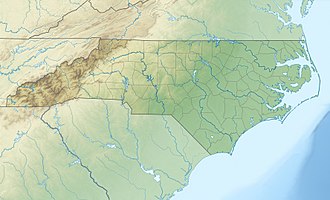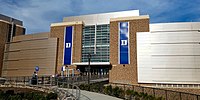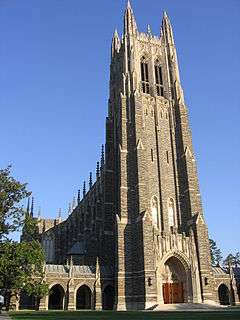Wallace Wade Stadium
Wallace Wade Stadium, in full Brooks Field at Wallace Wade Stadium, is a 40,004-seat outdoor stadium in the southeastern United States, located on the campus of Duke University in Durham, North Carolina. Primarily used for American football, it is the home field of the Duke Blue Devils of the Atlantic Coast Conference.
 Panoramic view from west in 2018 | |
 Durham Location in North Carolina  Durham Location in the United States | |
| Former names | Duke Stadium (1929–1967) |
|---|---|
| Location | Frank Bassett Drive Durham, North Carolina |
| Coordinates | 35°59′43″N 78°56′30″W |
| Owner | Duke University |
| Operator | Duke University |
| Capacity | 40,004 (2016–present) 33,941 (1982–2015) 40,078 (1978–1981) 44,000 (1942–1977) 35,000 (1929–1941) |
| Record attendance | 57,500 (November 19, 1949)[1] |
| Surface | Latitude 36 Bermuda Grass |
| Construction | |
| Broke ground | December 1928 |
| Opened | October 5, 1929 |
| Renovated | 2014–2017 |
| Expanded | 2016 |
| Construction cost | $4 million ($59.6 million in 2019[2]) |
| Architect | Horace Trumbauer[3] |
| Tenants | |
| Duke Blue Devils football (1929–present) | |
Opened 91 years ago in 1929,[4][5] it was the first facility in Duke's new West Campus. Originally Duke Stadium, it was renamed in 1967 for former head coach Wallace Wade. The playing surface was renamed Brooks Field at the beginning of the 2015 season after the removal of the track and lowering of the field-level seats.
History


Wallace Wade Stadium opened in 1929 as "Duke Stadium,"[7] largely funded with bonds—the school advertised for "1,000 individuals to invest $100 in Duke's athletic future" and offered 6% interest.[8]
The stadium is notable for being the site of the 1942 Rose Bowl on New Year's Day. Duke had won the invitation to the game as the eastern representative. However, the attack on Pearl Harbor on December 7, just weeks after the end of the 1941 season, led to fears of a Japanese attack on the West Coast. General John L. DeWitt, commander of the Western Defense Command, advised the Tournament of Roses Association not to hold the game at the Rose Bowl in southern California, since he was not willing to take a chance on the Japanese choosing to stage a bombing raid on a stadium with over 90,000 people in attendance. Soon afterward, the government banned all large public gatherings on the West Coast, which ruled out Bell Field in Corvallis, Oregon, the on-campus venue of Oregon State, the host team from the Pacific Coast Conference (PCC). The Tournament of Roses Association originally planned to cancel the game, but Duke officials invited the Rose Bowl and Oregon State to Durham to play the game, and the offer was accepted.
On a cold, rainy January 1, 1942, 56,000 fans, 22,000 of whom sat on bleachers borrowed from nearby NC State and UNC, watched the heavily-favored Blue Devils fall to the strong defense of the Beavers, 20–16.[9][10] It remains the only edition played outside of Pasadena, California.
In 1967, the venue was renamed for legendary head coach Wallace Wade.[7]
In 1972, Wallace Wade Stadium hosted the first edition of the Pelican Bowl, a short-lived attempt at a black college football national championship game between the winner of the MEAC and the winner of the SWAC. Grambling defeated NC Central by a score of 56–6 in front of 22,500 fans.[11] In October 2012, Duke announced major renovations projected to eventually seat 43,915.[12]
In 2015, Steve Brooks, Duke alumnus and CEO of the Phoenix American Insurance Group, donated $13 million to the Duke Athletics department. The playing surface was renamed Brooks Field in his honor.[13]
Renovations


In September 2014, renovation plans were released. The new stadium would seat nearly 40,000 and have 21 luxury suites housed within a new five-story, 90,000-square-foot (8,400 m2) tower along the stadium's west side. A new 42 feet (13 m) high by 75.6 feet (23.0 m) wide LED video board would be installed 90 feet (27 m) closer to the field than the previous one. Another notable feature was the removal of the stadium's track, which allowed 4,000 additional seats to be added along with lowering and recentering the field. The concourses along the stadium's north and west sides were enhanced with new concessions and new gates, restroom facilities and first aid stations. Integrated seating in compliance with the Americans with Disabilities Act were also added for disabled guests and their companions.[15] The first two phases of the renovations were finished over a two-year period, including the new press box, eight broadcast booths[16] and suites completed by the 2016 college football season.
Phase three was completed prior to the 2017 season. It included completion of ADA boxes currently in one-third of the concourse on the north and east concourse, rebuilding the concourse surface, and construction of a north gate ticket booth and various concessions, bathroom, and future store buildings on the east concourse. The alumni box on the north concourse was also be replaced with a new auxiliary scoreboard.[17]
Concerts
| Date | Artist | Opening act(s) | Tour / Concert name | Attendance | Revenue | Notes |
|---|---|---|---|---|---|---|
| April 24, 1971 | The Grateful Dead | — | — | — | — | This concert was part of Joe College Weekend.[18] |
| October 8, 2005 | The Rolling Stones | Trey Anastasio | A Bigger Bang Tour | — | — |
References
- "History" (PDF). Duke Athletics. Retrieved November 6, 2013.
- Federal Reserve Bank of Minneapolis. "Consumer Price Index (estimate) 1800–". Retrieved January 1, 2020.
- "Inventory of the Horace Trumbauer Architectural Drawings Collection, 1924 - 1958". Duke University. Retrieved November 6, 2013.
- "Panthers help Duke U. inaugurate new gridiron stadium at Durham". Pittsburgh-Post Gazette. October 5, 1929. p. 18.
- Hannum, Max E. (October 6, 1929). "Pitt swamps Duke, 52-7". Pittsburgh Press. p. 1, sports.
- Stevens, Patrick (2015-11-05). "Most memorable Duke-North Carolina football games". The News & Observer.
- "Brooks Field at Wallace Wade Stadium". Duke Sports Information. November 29, 2005.
- "Wallace Wade Stadium: A New Football Stadium and the Opening of West Campus". Duke University Archives.
- Feder, Sid (January 2, 1942). "Oregon State, Fordham win bowl tilts". Pittsburgh Post-Gazette. Associated Press. p. 12.
- Guenther, Jack (January 2, 1942). "56,000 fans stunned as OSC whips Duke Devils in Rose Bowl". Eugene Register-Guard. (Oregon). United Press. p. 10.
- Gaither, Steven (December 11, 2014). "The Lost Bowl Game: Black College Football's Championship Trial". Retrieved 2014-12-11.
- Patterson, Chip (October 1, 2012). "Duke Announces Major Renovations for 83-Year-Old Wallace Wade Stadium". CBS Sports. Retrieved 2013-09-08.
- "Duke adds Brooks Field to stadium name after $13M donation". AP via USA Today. July 17, 2015.
- "Check Out an All-Access Tour of Blue Devil Tower". Duke Sports Information. 2016-09-29.
- Wiseman, Steve. "Duke football looks ahead to refurbished Wallace Wade". www.heraldsun.com. Retrieved 2014-09-25.
- "Duke Wallace Wade Stadium". Retrieved 21 December 2016.
- "Stadium Renovations Enhance Football Experience". duke.edu. Retrieved 23 March 2018.
- "Wallace Wade Stadium - April 24, 1971 - Grateful Dead". www.dead.net. Retrieved 23 March 2018.
External links
| Wikimedia Commons has media related to Wallace Wade Stadium. |

